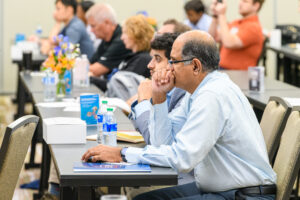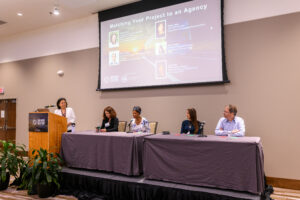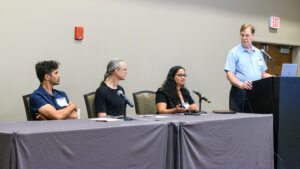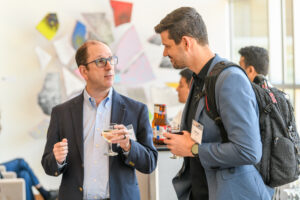The Research Park hosted America’s Seed Fund Road Tour, an opportunity for innovators, entrepreneurs, researchers, and small technology startups to explore over $4 billion in early-stage funding opportunities, on July 17.
“We are on the front of cutting-edge breakthrough technologies,” said University of Illinois Chancellor Robert J. Jones, discussing the University of Illinois and the Research Park’s role in technology and economic development.
U.S. Rep. Nikki Budzinski also spoke at the event, discussing the recent Illinois Fermentation and Biomanufacturing (iFAB) Hub funding. “This region has so many companies that leverage this federal funding, bringing the cutting edge of technology, research, and development right here to our backyard…We need to be making continued investment and partnership with [innovators].”

Champaign was one of five cities on the Road Tour’s Midwest swing, and the only stop not in a major metropolitan area. The event’s panels featured representatives from 22 federal agencies, including the USDA, USPTO, the Army, and NASA, who also held one-on-one meetings with entrepreneurs and innovators.
The Illinois stop was sponsored by the Illinois Innovation Network, the Illinois Federal and State Technologies (FAST) Center, and the University of Illinois Research Park. It attracted entrepreneurs and researchers from all across Illinois and beyond.
America’s Seed Fund Road Tour is a national outreach effort that conveys the technology funding opportunities provided through the U.S. Small Business Administration, America’s Seed Fund, the Small Business Innovation Research (SBIR), and Small Business Technology Transfer (STTR) programs.
View the time-stamped agenda or keep reading for event highlights and relevant resources.

The day opened with remarks from Laura Appenzeller, the Executive Director of the University of Illinois Research Park, and Dr. Gerald Wilson, the Director of EnterpriseWorks.
Throughout the morning, organizations had the opportunity to meet one-on-one with representatives from federal agencies. Individuals could schedule 15-minute meetings in advance or walk-ins.
“The one-on-one was amazing,” said Cezar Tondini, entrepreneur and founder of T-Sale Metals. “I had four meetings and everyone put me in the right direction. They gave me a lot of information…it was an amazing experience.”
Government Agency Reverse Pitches included presentations on resources from the following agencies:
- National Institute of Standards and Technology (NIST)
- Department of Homeland Security (DHS)
- United States Department of Agriculture (USDA)
- National Science Foundation (NSF)
- National Institute of Food and Agriculture (USDA NIFA)
- Department of Energy (DOE)
- National Aeronautics and Space Administration (NASA)
- Health and Human Services (HHS) and the National Institute of Health (NIH), including the S. Food and Drug Administration (FDA), Centers for Disease Control and Prevention (CDC), and Advanced Research Projects Agency for Health (ARPA-H)
- United States Navy
- Defense Health Agency (DHA)
- United States Army
- Missile Defense Agency (MDA)
- SpaceWERX/AFWERX
- NSF’s Innovation Corps (I-Corps)
- United States Patent and Trademark Office (USPTO)
- Federal Laboratory Consortium for Technology Transfer (FLC)

One theme of the panel “Matching Your Project to an Agency” was the vast breadth of topics and projects that are eligible for government funding.
“We have basically no topic limitations…the majority of our Phase I awards are to brand new companies in the SBIR world.” said Ben Schrag, panelist and SBIR/STTR Program Director and Policy Liaison at the NSF. He recommended these companies “think about the first user and the first value proposition” when submitting a proposal.
“There are many ways to win, but no double dipping,” said moderator Nancy Kamei, SBIR Program Development Specialist. “You cannot take two awards for the same exact work.” This enables a vast array of companies to receive funding.
Panelists also underscored the importance of reviewing feedback and trying again if a company’s application is denied.
“You’ve done the hard work,” said panelist Jacki Gray, SBIR Program Manager of the Technology Partnerships Office at NIST. “You’re going to get feedback and that’s going to give you confidence to come back strong the next round.”
“Inside the Head of an Evaluator” discussed project evaluation and was moderated by Elden Hawkes, Jr., SBA Partnership and Innovation Specialist, featuring panelists Shadi Azoum, Colleen Gibney, Gary Laier, and Bob Smith.
Bob Smith, a National Program Leader at USDA explained that the USDA’s evaluators come from academia, industry, state governments, national and international experts, and more. These evaluators measure innovation when reviewing applications, looking for novel concepts with a combination of technology infusion potential and commercialization.
To impress evaluators, companies should get to know the target audience, back up what they are promising with concrete knowledge, and plan ahead.
“Don’t wait until the very last minute to submit your proposal,” said panelist Shadi Azoum, SBIR/STTR Program Manager at NAVWAR. Bob Smith also emphasized the importance of writing your application well in advance and then “give [it] to someone to review [and] make sure it flows well…You want to put your best foot forward.”
“Finding Help and Support” moderator Katy Sly from the SBA and panelists Laura Appenzeller, Levi Kinnard, Molly Kocialski, and Ruth Shuman gave audience members help and support for the innovation journey.
One critical area where innovators need support is intellectual property, a topic that presents lots of early risks. Molly Kocialski, the Regional Director at the Rocky Mountain USPTO said that “early risks have to do with disclosure.” There’s a one-year grace period for applying for patents, so it’s important to consider these things early on. Unlike other represented agencies, USPTO doesn’t offer funding, but it has lots of already paid-for services. Kocialski underscored the importance of asking for help by visiting an office or using USPTO’s free online IP Identifier.
This panel recognized the challenges of an innovator’s journey and the features of federal programming that make it easier for entrepreneurs.
“It’s a long timeline,” said panelist Ruth Shuman from the NSF I-Corps program. “Don’t give up because you got one rejection. Figure out what the next steps are, [and] be the person to plan…and work through a strategy that includes patents, capital, and SBIR support.”
Several speakers shared about State of Illinois support programs, including:
- Emerging Technologies Manager Jamie Gladfelter spoke about the SBIR Phase Match Program, a 5-million-dollar annual fund that provides a 1:1 match to Illinois-based companies that have received an SBIR/STTR Phase I award.
- Illinois DCEO Venture Capital Program Platform Coordinator Jennifer Givens spoke about the Illinois Innovation Venture Fund (INVENT), a $114 million fund investing in innovative startups through direct equity investments, supporting founders and companies that lack access to venture capital funding.
- Illinois Science and Technology Coalition Director of Strategic Partnerships Kate Calabra spoke about the Illinois Innovation Vouchers Program, which provides funding to small and mid-sized businesses to partner with Illinois higher-education institutions for research and development.

The event included two segments with four total breakout sessions, each moderated by Illinois FAST Center Consultants.
- “Biomedical AI” was moderated by Illinois FAST Center Manager Shelley Maves and featured panelists from Prenosis, SimBioSys, and LivLabs. Prenosis spent two years in the EnterpriseWorks incubator before relocating to Chicago, Illinois. It still takes advantage of SBIR resources from the Research Park. SimBioSys is a computational oncology company located in the EnterpriseWorks incubator.
- “Clean/Climate Tech” was moderated by Platinum Grants & Proposals founder Heidi Platt and featured panelists from SunFarmor and EnterpriseWorks startups Natrion and Cache Energy. In the discussion, Natrion founder Alex Kosyakov offered advice about technology implementation: “You got to be boots on the ground seeing the most effective places where you can implement your technology…connecting the dots between the defense application and the commercial opportunities, that is what has made an effective proposal for us.” Cache founder Arpit Dwivedi stressed that “raising money is not the goal…The goal is to build something that works and that people can use.”
- “Biomanufacturing” was moderated by consultant Kris Parmelee and featured panelists from iFAB, Hydrosome Labs, and the Midwest Bioprocessing Center. The panel discussed how Central Illinois is becoming a hub for biotech and fermentation research, partially thanks to the Integrated Bioprocessing Research Laboratory (IBRL). “IBRL helps companies get their technologies from the bench and de-risk them on the way to commercialization,” said Beth Conerty. Building out IBRL and iFAB supports startups at their early stages to keep business in Central Illinois. Conerty also highlighted the services provided by the Research Park, including “everything from socialization, to helping client CEOs, to entrepreneurs in residence, to SBIR writing support, to access to the I Corps program.”
- “Quantum/Semiconductors” was moderated by consultant Roland Garton and featured panelists from NuCrypt, Inprentus, and Cygnus.
Lightning presentations included:
- Illinois Innovation Network-Falling Walls
- Illinois VENTURES/Illini Angels
- Great Lakes Region I-Corps Hub
- Illinois AgTech Accelerator
- Evergreen Climate Innovations/ANL Chain Reaction Innovations
- Serra Ventures
- AFRL Regional Network- Midwest
- Polsky Deep Tech Ventures (Resurgence, Duality, Transform)
- DPI Ventures
- TechNexus Venture Collaborative

Thank you to the event sponsors: The Illinois Innovation Network, Illinois FAST (Federal and State Technologies) Center, and The University of Illinois Research Park.
Thank you to the U.S. Small Business Administration and the event planning team, including Shelley Maves, Cheri Soliday, Illinois FAST Center leadership, and the Research Park team, for making this event possible.
